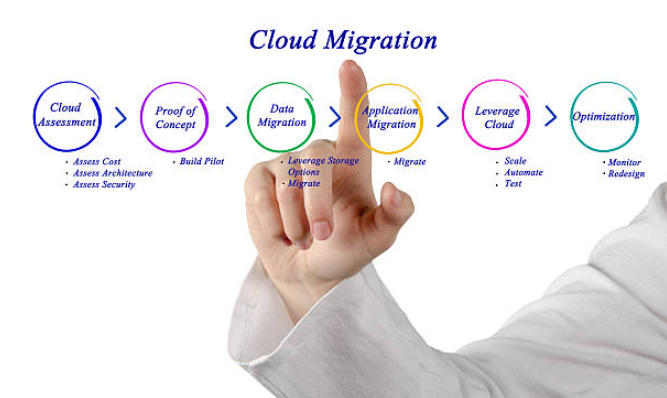Cloud migration should be a top priority for any business that is looking to stay competitive. The cloud offers several benefits that can help your business grow and succeed.
Cloud migration services can help you reduce costs, increase efficiency, and improve customer service. This article will explore the benefits of cloud migration and how it can help your business grow.
What is Cloud Migration?
Cloud migration is the process of transferring data and applications from a local server to a remote server. The main benefit of this is that it makes accessing data and applications more convenient, as they are no longer stored on a computer or laptop.
This process is also beneficial for companies that have offices in more than one location. This way, they can access their data from any location, which helps them save time and resources.
The following are two of the main ways in which companies can migrate their data to a remote server.
- Offsite Backup – A company’s data is stored on one or more servers and then copied to a remote server at the same time to be accessed online. This method allows access to be available from different locations, making it easier for employees and clients.
- Cloud Storage – Data is stored on a remote server that is connected via an internet connection. This method allows for remote access to the data. The data is accessible from any device with an internet connection.
- Cloud Backup – A company’s data is stored on one or more servers, and then copied to a remote server at the same time, to be accessed online. This method allows for access to be available from different locations, making it easier for employees and clients.
- Backup Management Software – Allows companies to back up files automatically according to a schedule or manually by user request. These companies can back up custom data as well as track how long it takes for them to complete backups.
Read Also: Optimize Server Performance with Real-Time Monitoring
5 Benefits of Cloud Migration
-
Security
When done correctly, cloud computing can be more secure than traditional network systems. The cloud provides much stronger security than traditional data centers because it stores your business information and data centrally. The majority of popular cloud providers also include numerous security features, such as security analytics, periodic updates, and cross-enterprise visibility.
Security issues are usually handled by cloud providers, including preventing unwanted traffic from accessing machines where your business data and apps are stored and making sure that automatic security updates are applied to their systems to ensure they are protected from the latest security threats.
-
Scalability
By moving to the cloud, your company will be able to scale up or down based on its IT requirements and business plan. An IT solution that was perfect one year may be obsolete a few years later, making it difficult for businesses to adapt to changing customer demands.
With cloud migration, organizations can dramatically reshape their infrastructure and workloads to meet the needs of today without being bound by the equipment and assets that were appropriate in the past. The cloud empowers you to manage your resources based on your business requirements.
This level of control over your business saves you money on the costs of maintaining large data centers that rarely live up to their promises and potential.
-
Cost
You can help to reduce operational costs while improving IT processes by migrating to the cloud. Switching to the cloud also means that you only pay for what you use; there is no need to maintain expensive data centers when your critical information is hosted in the cloud. According to a Microsoft Office 365 survey, 82% of SMBs report lower costs as a result of cloud adoption, and 70% reinvest the savings back into their business.
According to an Accenture study, enterprises that run cloud services save the most money on energy costs after switching. Migrating to the cloud can reduce operational costs for businesses of all sizes while increasing IT productivity and processing. The cost advantages of cloud computing are limitless.
-
Integration
Traditionally, a company that uses a data center would have to perform an infrastructure refresh regularly to keep its data center software and hardware up-to-date and operational. This is a costly, time-consuming, and repetitive task that consumes valuable time and resources.
Instead, at the end of a hardware refresh cycle, businesses can now migrate applications to the cloud. The cloud provider handles hardware and software updates, saving money and time while ensuring applications are always supported by the most up-to-date infrastructure.
Cloud services and applications are constantly being improved, updated, and expanded to meet the needs of businesses and consumers. This means that your new cloud environment can grow and expand to meet your changing business requirements.
-
Access
Because your data is stored in the cloud, it can be accessed regardless of what happens to your physical equipment. By migrating to the cloud, members of your organization will be able to access critical data and business information from anywhere in the world on any device.
This creates numerous opportunities for your company to grow and expand while meeting operational requirements.
Many cloud services can also monitor your mission-critical apps and machines. Being notified when there is an outage or when an app has potential issues can significantly shorten the time it takes to restore services and resolve problems. When compared to the traditional approach of keeping track of the state of your services on your own, this can save your company time and money.
What are the types of cloud migration strategies?
There are several options when considering workload migration.
- Relocating This strategy, perhaps the most basic form of migration, refers to moving VMware VMs from on-premises hardware to VMC. This can be accomplished by starting from scratch, performing a cold migration, or performing a live migration.
- Reproduction from the Ground Up While this isn’t technically a migration, it may be an option for some of your cattle workloads. Rather than moving them, it may be possible to spin them up as new workloads in VMware Cloud on AWS. Simply recreate them in the cloud and turn off the old ones in your on-premises environment.
- Cold Migration The next migration strategy is a cold migration, which involves stopping a workload, moving it to your VMware Cloud on AWS, and restarting it there. This option may be appropriate for non-production workloads where you can simply turn it off with little business impact (e.g., development or test workloads).
- Replatforming This model modifies or replaces specific components to better take advantage of the cloud provider’s features, such as switching to managed services or replacing commercial off-the-shelf software with an open-source equivalent.
- Repurchasing replaces the existing application with an already available cloud-based version from the cloud provider’s marketplace, effectively replacing one license fee with another. This method is frequently used for older on-premises ERP, finance, CRM, or HR applications that have comparable functionality in an app marketplace or as a SaaS application. This is also an excellent option for legacy applications that cannot be easily virtualized or migrated in other ways.
- Refactoring This approach necessitates a complete re-architecture of an application to take advantage of unique cloud provider features. When cloud-native features are required, or when the agility and scalability of micro-services-based applications necessitate it, these applications are typically broken up into smaller pieces or services and often deployed on one or more public clouds. Although this is the most expensive method of migration, the benefits can far outweigh the risks. As the increased benefits of cloud-native applications beckon, many applications that were migrated using another strategy may be refactored over time.
- Retaining This is not a true migration; rather, it is the retention of an application on its existing on-premises infrastructure. If a significant investment remains, or if a critical application is still running on legacy mainframe or minicomputer platforms, the organization may wish to keep those well-behaved and productive applications in place, integrating with cloud-based resources via APIs. As a result, a hybrid cloud migration strategy with workloads in both public and private clouds is implemented.
- Retiring Every application becomes obsolete, either because of redundancy or because better options are available in a cloud-based offering.
What are the challenges of cloud migration?
Anticipating potential problems is a critical component of your cloud migration strategy.
- Cost management — While the cloud can provide cost savings, determining the cost of the cloud can be difficult. Cloud costs are often underestimated. Consider not only the costs of migration, but also the costs of migration services, the potential need for additional bandwidth, and future recurring expenses. (Proper planning and cloud cost optimization come in handy here.)
- Complexity — While the public cloud is generally easier to manage, it can become complex (and fast if you start introducing hybrid cloud elements). Your employees must be capable of managing your cloud and comprehend the effort required for a successful migration.
- Dependencies — Application dependencies can quickly become complicated and bring migrations to a halt. Cloud provider discovery tools can help you keep track of all of them.
- Stakeholder support — When it comes to the cloud, you want leadership that is committed to the long game. This is where establishing a Cloud Center of Excellence pays off big time.
- Developing cloud fluency — A centralized cloud team cannot scale. Cloud fluency ensures that your entire organization is on the same page, preventing a small pool of cloud experts from being overburdened as cloud translators.
- Stakeholder support — When it comes to the cloud, you want leadership that is committed to the long game. This is where establishing a Cloud Center of Excellence pays off big time.
- Developing cloud fluency — A centralized cloud team cannot scale. Cloud fluency ensures that your entire organization is on the same page, preventing a small pool of cloud experts from being overburdened as cloud translators.
Conclusion
Cloud migration is a cost-effective way to keep up with the fast-changing digital landscape.
As one of the biggest trends in the IT industry, businesses are increasingly shifting from on-site storage to cloud storage due to its many advantages. The cloud allows you to store data securely in a remote location while ensuring seamless access from anywhere with an internet connection.
This makes it easier for companies to collaborate and share information with remote employees. If you’re looking for a secure way to store and organize your files, check out the Best Cloud Storage for Photos and Pictures for reliable solutions.








